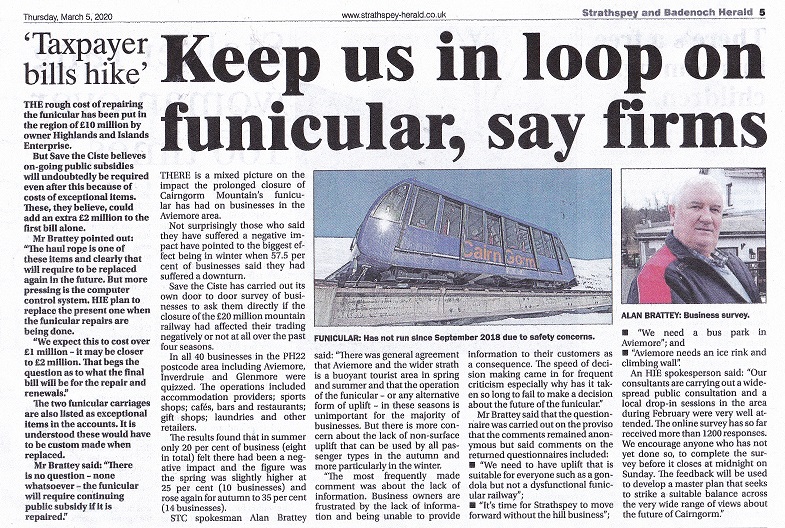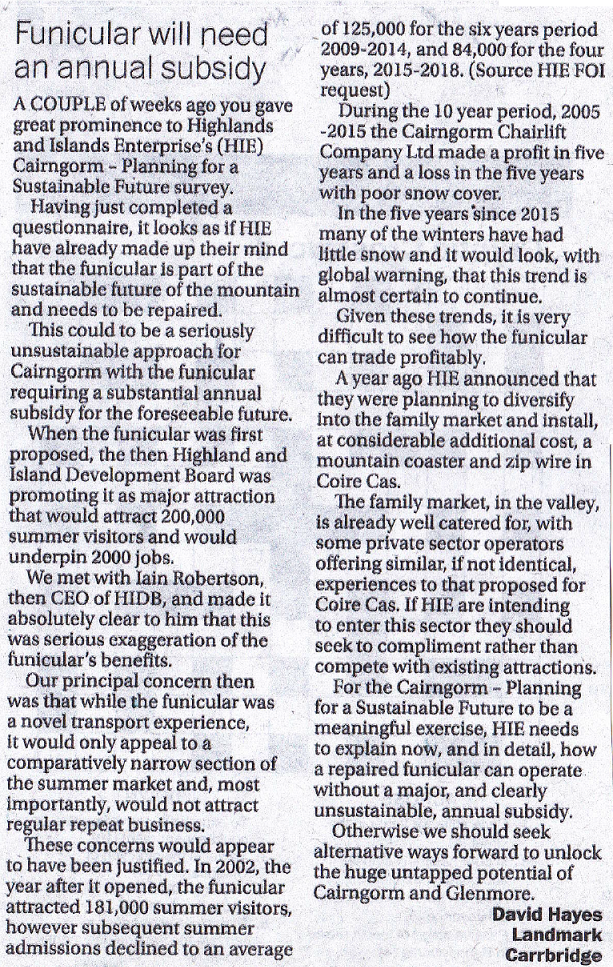 The announcement yesterday that Highlands and Islands Enterprise is submitting a Planning Application to repair the Funicular (see here), despite still not knowing what this would cost, was predictable. As far back as September of last year, HIE made it clear that their intention was to repair the Funicular.
The announcement yesterday that Highlands and Islands Enterprise is submitting a Planning Application to repair the Funicular (see here), despite still not knowing what this would cost, was predictable. As far back as September of last year, HIE made it clear that their intention was to repair the Funicular.
This was evidenced by Audit Scotland’s Section 22 report, “The 2018/19 audit of Highlands and Island Enterprise: Cairngorm Mountain and the Funicular Railway” which stated:
‘’While HIE’s intention is to repair and reopen the funicular, it is still not clear how much it will cost to do so, how it will be afforded, or what impact it will have on HIE’s financial sustainability. HIE has recognized these risks and raised them with the Scottish Government. Tough decisions are likely to be required over the coming months’’
What HIE have consistently failed to do is to demonstrate how they plan to lead the mountain business to commercial viability and sustainability, given that all the evidence shows that the business was a commercial failure when the Funicular was operating. This post takes a look at the issues that need to be addressed.
The drop in the number of tourist passengers carried by the Funicular has been well documented as has the collapse in the CairnGorm Mountain share of the Scottish Snowsports market which fell to <24% in the 2017/18 season which was the last one before the Funicular failed (see here). The inbuilt operational inefficiencies (see here) will continue to plague the business into the future and there has been no indication of how HIE intend to address these difficulties if in fact they do have a plan for that.
Costs of operating the funicular once repaired
HIE have also been careful to avoid any reference to the fact that the Funicular, if repaired, will continue to be subject to a publicly financed subsidy. The operating company has a full maintenance lease, with exceptions. The exceptions are all expensive hardware items that the operator does not have to finance, if and when they require to be replaced. There are 11 items on that list:
- Haul Rope.
- Counter Rope
- Rail
- Motor Invertors Control
- Electric Motors [500Kw [2]]
- Standyby Generator top
- Hydrostatic Drive
- Gearbox
- Bogie including 3 track brakes
- Carriage Replacement
- Train Control Computer.
The Haul Rope was replaced in 2018, prior to the Funicular failure, at a cost of approximately £100k. The very fact that HIE continues to fund the replacement of these exceptional items is further evidence that the Funicular hasn’t been commercially viable and that position will not change if it is repaired.
On 21 December 2000, Fergus Ewing MSP had this to say: ‘’Claims that the Funicular Railway is reliant on public money are totally absurd’’. Given that he is now the Scottish Government Cabinet Secretary with responsibility for HIE, and as such he’ll certainly be closely involved in the decision to remove or repair it, I certainly hope that he has carefully reflected on the statement he made 19 years ago and of David Hayes’ letter in the Strathy:

Unfair public subsidies and a conflict of interest
Is providing a public subsidy to one snow-sports area and not the others anti- competitive? It’s certainly not a moral position to take and it further demonstrates the significant conflict of interest that has arisen by HIE clearly favouring the snow-sports area that they own against the others in the area for which they are responsible.
This isn’t simply a matter of a subsidy for the Funicular. Cairngorm Mountain received 100% grant funding for snowmaking equipment that cost £1m pounds while the other snowsport areas were awarded 40% grant funding for snowmaking equipment that cost less than £500k. HIE has also been underwriting the losses that have being made since the business was effectively nationalised at the end of November 2018. None of the other snow-sports areas within HIE’s area of operation are enjoying such largesse. That’s a gross injustice and it most certainly isn’t providing a level competitive playing field.
The consultation is biased and designed to avoid awkward questions
The consultants that HIE appointed to assist with the development of a ‘Masterplan’ for Cairngorm going forward (see here) will now have the responses to the online questionnaire that closed at midnight on Sunday 8 March . It’s expected that their report will be completed by the end of May 2020 so we will have to wait until at least then to read their conclusions
Notably, the online questionnaire failed to ask any searching questions about the reasons for the fall in passenger numbers or the collapse of the Snowsports market share. Quite how a Masterplan will address these two major issues without knowing what caused them isn’t clear.
Another very clear omission was the failure to ask any question about the future of Coire na Ciste. It would not have been difficult to have asked: ‘’Do you think that Chairlifts should be restored to Coire na Ciste, Yes or No, please give a reason for your answer’’. Alas, there was nothing like that included, which simply adds to the suspicion that surrounds the Masterplan process.
The questionnaire also failed to ask any questions that would have provided empirical evidence about the impact of the closure of the Funicular on local businesses over the previous 17 months. An offer was made to the consultants to conduct doorstep research amongst tourism related businesses in the PH22 Postcode District (Aviemore, Inverdruie and Glenmore) when agreed questions could have been asked. That offer wasn’t taken up, although it would have been done free of charge. That fuels the suspicion that HIE, as the paymasters, have directed the consultants to steer clear of uncovering any evidence that might not support the view that the Funicular Railway is fundamentally important to the local economy.
I decided to go ahead with the doorstep research anyway and asked 40 businesses to say if the closure of the Funicular had negatively impacted their businesses in Spring, in Summer, in Autumn and in Winter. The answers were conclusive ,with 80% of the businesses surveyed reporting that the closure had not affected them at all in Summer. In the Winter, when the Funicular could be expected to be vitally important, only 56.5% of business said that the closure had been a negative for them. Why has HIE consistently failed to conduct any market research survey amongst Strathspey based businesses? This empirical evidence, summarised below, has been passed on to the Scottish Government and it will be interesting to find out if they are listening or will they just continue to support their discredited Enterprise Agency.
Question: Has the closure of the Cairn Gorm Funicular affected your business either negatively or not at all?
Negatively Not at All
In Spring 10 [25%] 30 [75%]
Summer 8 [20%] 32 [80%]
In Autumn 14 [35%] 26 [65%]
In Winter 23 [57.5%] 17 [42.5%]
There was general agreement that Aviemore and Strathspey is a buoyant tourist area in Spring and Summer and that the operation of the Funicular [or any alternative form of uplift] in these seasons is unimportant, for the majority of businesses. There is more concern about the lack of non-surface uplift that can be used by all passenger types in the Autumn and more particularly in the Winter.
More detailed research should have been done by the Consultants but the results would not have suited HIE’s agenda and the issue was neatly avoided.
Further suspicion arose when the Aviemore and Glenmore Community Trust sent out 7 questions to the membership. The questions were:
- Infrastructure – Priorities for new infrastructure, timescale and what is critical. How would the need be validated?
- Access – During the non-skiing season should access to the plateau still be controlled. What impact would more visitors have on Cairngorm and the surrounding estates.
- Seasonality – What are the likely effects of climate change on the community, environment and economy.
- History – What has worked well and what could have been better.
- Funicular – What is the impact of the Funicular not running on both direct and indirect employment.
- Elsewhere – What has been seen in other places that would work well on Cairngorm
- Sustainability – How do we create community, environmental and economic sustainability.
It was my view that these were a particularly poor set of questions with No 5 in particular being very leading and biased. It was also notable that the Community Trust also steered well clear of asking their members what they thought about returning uplift to Coire na Ciste despite having made a commitment to consult widely about that issue, at their 2018 AGM. Regrettably, the Directors have never yet honoured that commitment.
HIE’s consultants were asked if they had had a hand in formulating the A&GCT questions. Their response was:
‘’Neither we [Jura Consultants] nor 360 Architecture devised the A&GCT questions. A&GCT based their questions on a discussion that we had with members of the A&GCT Board and reflected the themes that were discussed. We did not see their questions in advance of them being sent out to A&GCT members’’
That appeared to be a clear enough response but the A&GCT has refuted this and said:
‘’….the questions were put to us at the meeting by Three Sixty and Jura Consulting. We quoted the questions verbatim to our members’’
It seems then that the A&GCT were led to the questions that they asked. Will the responses to their questionaire now be considered independently of the analysis done by the consultants? The suspicion is that HIE hopes to point to the “independent” [but biased] responses as evidence that the Funicular should be repaired because, for example, its closure has led to a loss of employment.
What needs to happen now
Suspicion surrounds the Master Planning process. It seems that deliberate efforts have been made to avoid collecting direct evidence about the importance or otherwise of the Funicular Railway to the Strathspey economy. Politicians and the public that they serve are simply being expected to believe the HIE line that the Funicular is vital to the economic well being of the Strathspey area. There has been no rigorous market research conducted that would provide detailed empirical evidence, one way or the other. Any decision to repair the Funicular could therefore be made on a false premise and the empirical evidence published in this report would in fact suggest that will be the case if it is repaired.
The Scottish Government has sufficient evidence to have grave concerns about the advisability of allowing over £10m pounds of public money to be committed to supporting HIE’s failed Funicular strategy. The people are entitled to expect our government to make the right decision and to have the Funicular removed and replaced with an alternative form of uplift that is suitable for use by everyone in all seasons of the year.
